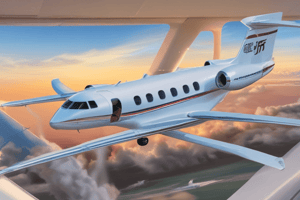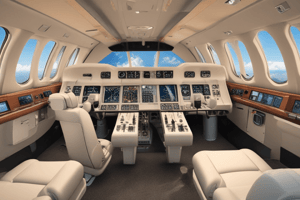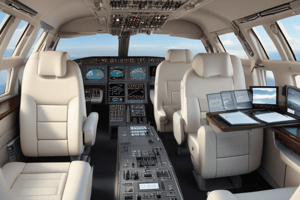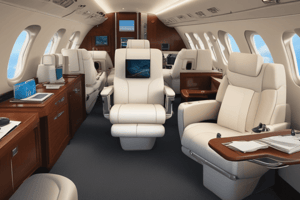Podcast
Questions and Answers
What components power the aircraft Fly-By-Wire (FBW) primary Flight Control System?
What components power the aircraft Fly-By-Wire (FBW) primary Flight Control System?
Aircraft electrical and hydraulic systems
How many FCC channels are powered when the EBHA switch is turned ON?
How many FCC channels are powered when the EBHA switch is turned ON?
2 (channels 1B and 2A)
After the SPOST initiation, which FCS CAS message should be the only one displayed?
After the SPOST initiation, which FCS CAS message should be the only one displayed?
FCC Alternate Mode (caution)
What happens if one hydraulic system is lost in terms of primary flight control surfaces?
What happens if one hydraulic system is lost in terms of primary flight control surfaces?
What initiates within 10 seconds after the UPS switch is turned ON?
What initiates within 10 seconds after the UPS switch is turned ON?
Which components are part of the primary FCS architecture?
Which components are part of the primary FCS architecture?
What are the primary flight control surfaces on the G650ER aircraft?
What are the primary flight control surfaces on the G650ER aircraft?
How are the flight control surfaces actuated on the G650ER?
How are the flight control surfaces actuated on the G650ER?
What are the main components of the primary Flight Control System (FCS)?
What are the main components of the primary Flight Control System (FCS)?
How are the pilot and copilot flight controls linked in the G650ER?
How are the pilot and copilot flight controls linked in the G650ER?
What is the purpose of the artificial feel mechanisms in the flight control system?
What is the purpose of the artificial feel mechanisms in the flight control system?
What are the other systems related to the primary Flight Control System (FCS) on the G650ER?
What are the other systems related to the primary Flight Control System (FCS) on the G650ER?
What is the purpose of the bungee rods in the flight control system?
What is the purpose of the bungee rods in the flight control system?
How are the pilot and copilot rudder pedals connected?
How are the pilot and copilot rudder pedals connected?
What is the purpose of the Backup Flight Control Unit (BFCU) in the flight control system?
What is the purpose of the Backup Flight Control Unit (BFCU) in the flight control system?
Describe the redundancy in the Flight Control Computer (FCC) system.
Describe the redundancy in the Flight Control Computer (FCC) system.
What is the purpose of the control laws implemented in the Flight Control Computers (FCCs)?
What is the purpose of the control laws implemented in the Flight Control Computers (FCCs)?
Describe the redundancy and dissimilarity features of the Flight Control Computer (FCC) system on the G650ER aircraft.
Describe the redundancy and dissimilarity features of the Flight Control Computer (FCC) system on the G650ER aircraft.
Explain the role and purpose of the Backup Flight Control Unit (BFCU) in the G650ER flight control system.
Explain the role and purpose of the Backup Flight Control Unit (BFCU) in the G650ER flight control system.
Describe the purpose and operation of the Electrical Backup Hydraulic Actuators (EBHAs) in the G650ER flight control system.
Describe the purpose and operation of the Electrical Backup Hydraulic Actuators (EBHAs) in the G650ER flight control system.
Explain the purpose and operation of the Horizontal Stabilizer Trim System (HSTS) on the G650ER aircraft.
Explain the purpose and operation of the Horizontal Stabilizer Trim System (HSTS) on the G650ER aircraft.
Describe the role and operation of the Rudder Elevator Computers (REUs) in the G650ER flight control system.
Describe the role and operation of the Rudder Elevator Computers (REUs) in the G650ER flight control system.
Explain the purpose and conditions for entering the Maintenance mode in the G650ER flight control system.
Explain the purpose and conditions for entering the Maintenance mode in the G650ER flight control system.
How does the Horizontal Stabilizer Trim System (HSTS) interact with the Flight Control Computers (FCCs) during normal operations?
How does the Horizontal Stabilizer Trim System (HSTS) interact with the Flight Control Computers (FCCs) during normal operations?
In the event of a dual FCC failure and the BFCU activating, how would pitch control be impacted?
In the event of a dual FCC failure and the BFCU activating, how would pitch control be impacted?
Explain the purpose and function of the Horizontal Stabilizer Trim System (HSTS) in the G650ER's flight control system.
Explain the purpose and function of the Horizontal Stabilizer Trim System (HSTS) in the G650ER's flight control system.
Describe how the Flight Control Computers (FCCs) monitor and respond to potential pitch control issues in the G650ER.
Describe how the Flight Control Computers (FCCs) monitor and respond to potential pitch control issues in the G650ER.
What is a potential consequence of entering maintenance mode on the FCC system while in flight?
What is a potential consequence of entering maintenance mode on the FCC system while in flight?
Explain the purpose and function of the Rudder Elevator Computers (REUs) in the G650ER's flight control system.
Explain the purpose and function of the Rudder Elevator Computers (REUs) in the G650ER's flight control system.
How do the Rudder Elevator Units (REUs) contribute to the redundancy of the primary Flight Control System?
How do the Rudder Elevator Units (REUs) contribute to the redundancy of the primary Flight Control System?
Describe the maintenance mode capabilities of the G650ER's flight control system.
Describe the maintenance mode capabilities of the G650ER's flight control system.
If one FCC channel fails, what is the impact on the overall Flight Control System operation?
If one FCC channel fails, what is the impact on the overall Flight Control System operation?
Explain the role of the Flight Control Computers (FCCs) in the G650ER's flight control system architecture.
Explain the role of the Flight Control Computers (FCCs) in the G650ER's flight control system architecture.
How does the FCC system handle disagreements between the pilot and co-pilot inputs during flight?
How does the FCC system handle disagreements between the pilot and co-pilot inputs during flight?
Describe the redundancy and communication architecture of the G650ER's flight control system.
Describe the redundancy and communication architecture of the G650ER's flight control system.
Flashcards are hidden until you start studying
Study Notes
Aircraft Fly-By-Wire (FBW) Primary Flight Control System
- Powered by multiple components including Flight Control Computers (FCCs), hydraulic systems, and Electrical Backup Hydraulic Actuators (EBHAs).
- When the EBHA switch is ON, all FCC channels are powered to ensure full redundancy.
- After SPOST initiation, only the "FCS Ready" CAS (Crew Alerting System) message should be displayed.
- Loss of one hydraulic system affects the primary flight control surfaces by limiting control surface effectiveness but redundancy allows continued operation.
- Within 10 seconds of activating the UPS (Uninterruptible Power Supply) switch, backup systems initiate to maintain operational integrity.
Primary FCS Architecture Components
- Main components include FCCs, BFCU (Backup Flight Control Unit), hydraulic actuators, and various sensors.
- Primary flight control surfaces on the G650ER consist of ailerons, elevators, and rudder.
- Flight control surfaces are actuated through hydraulic systems and electromechanical actuators to ensure precision and reliability.
Pilot and Copilot Flight Controls
- Pilot and copilot controls are interconnected through a system of mechanical linkages and sensors to ensure synchronized operation.
- Artificial feel mechanisms provide pilots with tactile feedback, simulating aerodynamic resistance for improved control.
Related Systems to Primary FCS
- Systems include the Horizontal Stabilizer Trim System (HSTS) and Rudder Elevator Computers (REUs), enhancing stability and control.
- Bungee rods serve to maintain neutral positions and provide physical feedback during control input.
Backup Flight Control Unit (BFCU)
- The BFCU ensures continued flight control functionality in case of FCC failure, enhancing redundancy.
- Redundancy in FCC systems includes multiple channels that operate independently yet collaboratively.
Flight Control Computer (FCC) System Features
- Control laws are implemented in FCCs to manage flight envelope and ensure stable flight under various conditions.
- Redundancy is established through dissimilar FCC channels, capable of cross-monitoring inputs for consistent performance.
Horizontal Stabilizer Trim System (HSTS)
- HSTS adjusts the horizontal stabilizer's position for trim, maintaining desired flight angle with minimal pilot input.
- During normal operations, HSTS interacts with FCCs to optimize aircraft stability and response.
Pitch Control and FCC Failures
- In the event of dual FCC failure, activation of BFCU allows basic pitch control through alternate means, albeit with reduced capability.
- Monitoring of pitch control issues is performed by FCCs, which can enact corrective measures or warn pilots if deviations are detected.
Maintenance Mode
- Entering maintenance mode can limit functionality, resulting in potential consequences if attempted mid-flight, like loss of control authority.
- Maintenance mode capabilities allow for diagnostics without affecting flight operations, but restrictions apply.
Redundancy and Communication
- System architecture ensures robust redundancy and effective communication between pilot and co-pilot inputs, with conflict resolution protocols in place for discrepancies.
Impact of FCC Channel Failure
- If a single FCC channel fails, the system continues to operate with remaining channels, but potential for reduced response or capability may arise.
Monitoring and Response to Control Issues
- FCCs have built-in monitoring systems that log discrepancies, continuously adjusting to maintain optimal control during flight operations.
Studying That Suits You
Use AI to generate personalized quizzes and flashcards to suit your learning preferences.




